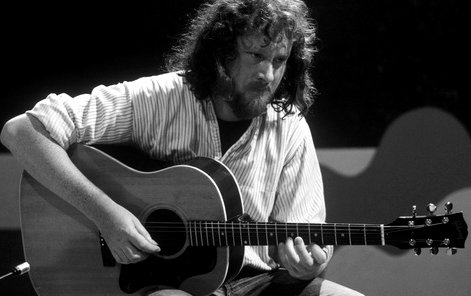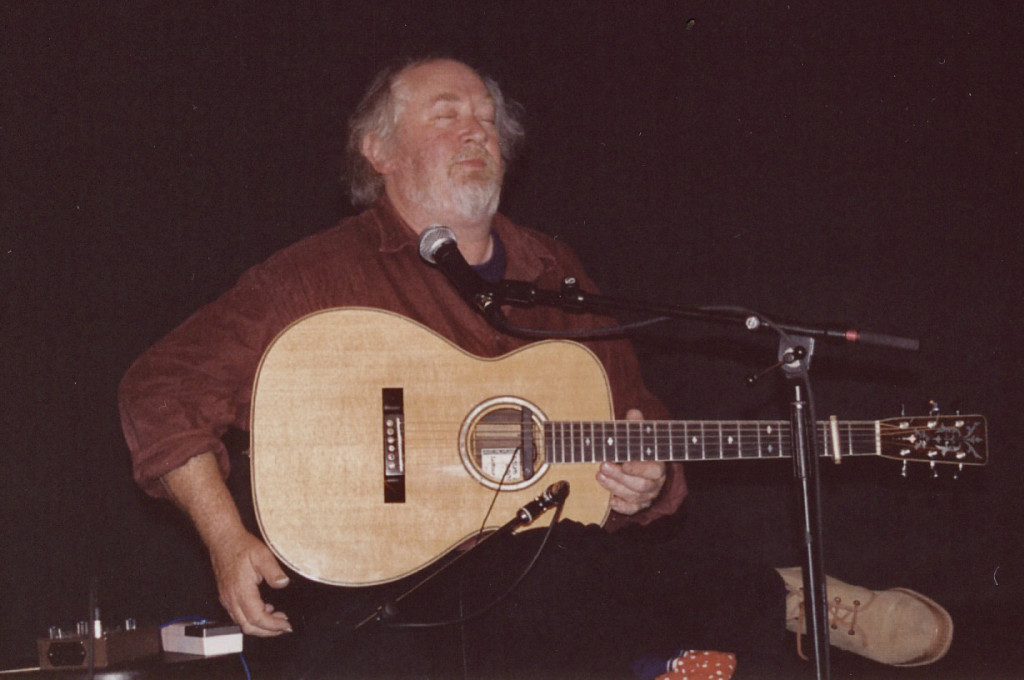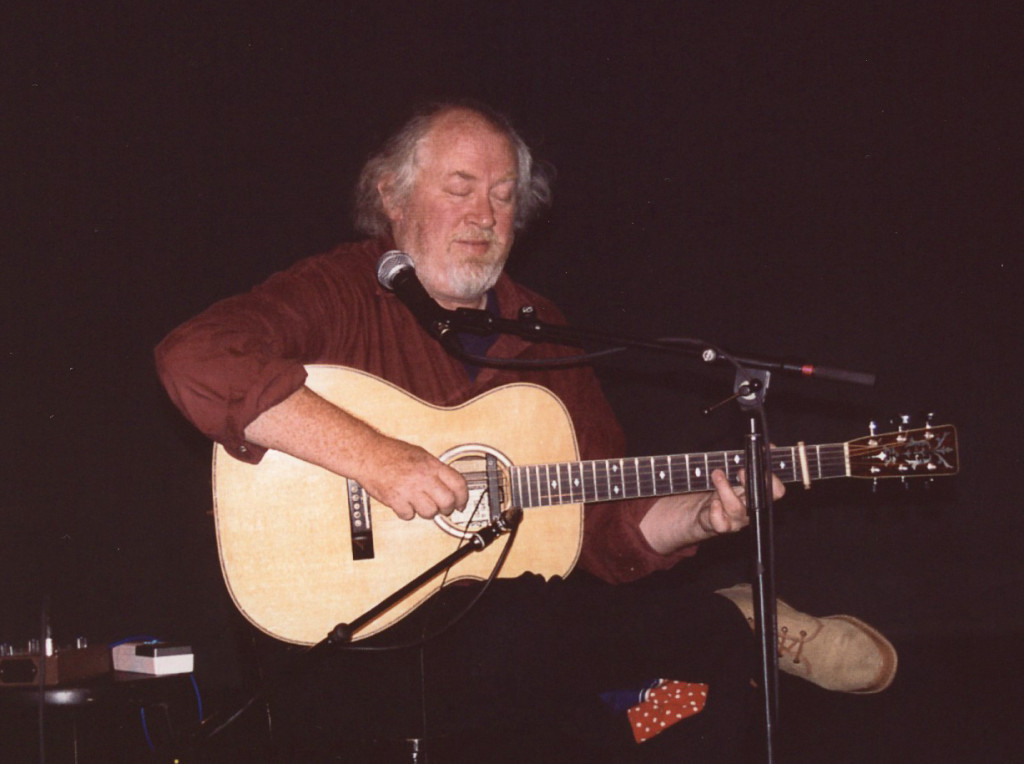– John Renbourn in the 1960s.
In the UK and Ireland, the 1960’s were a hot bed of musical innovation. Particularly so for acoustic guitar players. The “folk music revival” of that time fostered interest in the American acoustic finger picking styles of the Rev. Gary Davis, Doc Watson, Mississippi John Hurt, Elizabeth Cotten, Dave Van Ronk, Joseph Spence, Blind Lemon Jefferson, Merle Travis and many more “roots” musician. Guitarists of today probably do not realize the extent of the volatility of the acoustic guitar scene of that era. Memories of that scene have been somewhat over shadowed by the explosive growth of the “British Rock and Roll” phenomenon and electric guitar scene that followed shortly after. At that time acoustic guitarists were very fortunate to be exposed to the increased availability of recorded material, a huge number of touring folk musician legends, and a steady improvement in the quality of acoustic instruments. The acceptance of the guitar into the traditional folk scene was not immediate. The guitar was then considered foreign to the unaccompanied vocal traditions that were prevalent in the folk clubs. However, a number of acoustic guitarists adapted the imported styles and created blends of techniques and musical styles to create new, unique ways of playing “folk music”. Innovators of the day included Davey Graham (the inventor of DADGAD tuning), Nic Jones, Martin Carthy, Bert Jansch and of course John Renbourn. Most of the innovators have gone and the only one still playing at the peak of his powers is probably Martin Carthy. Nic Jones is till alive but still suffering the effects of a catastrophic car accident. On March 26, 2015 at the age of 70 years John Renbourn passed away. Here is a reprint of his obituary in THE GUARDIAN…..
“John Renbourn, who has died aged 70, was one half of the powerful guitar duo of Pentangle, the innovative jazz-folk band of the 1960s and 70s. While his fellow guitarist, Bert Jansch brought great emotion and inventiveness to his playing, it was Renbourn who provided a high level of technical accomplishment. They reveled in one another’s virtuosity.
The two men first met when Renbourn went to a Jansch gig at Bunjies coffee bar, London, in 1964. At the time Renbourn was performing informally at clubs in London, and as an accompanist for the African-American blues and gospel singer Doris Henderson from Los Angeles, with whom he recorded two albums, There You Go (1965) and Watch the Stars (1967). By early 1965, Renbourn and Jansch were flat-sharing, playing guitar together by day and performing in the evenings, developing a style that became known as “folk baroque”.
Jansch played on a couple of tracks on Renbourn’s eponymous first solo album for Transatlantic Records in 1965, and Renbourn repaid the compliment on Jansch’s Jack Orion (1966). Both were influenced by the guitarist Davey Graham, and their joint, largely instrumental album, Bert and John (1966), set the scene for their Pentangle collaboration with its modern jazz influences.
By the time of Renbourn’s second solo album, Another Monday (1967), he was collaborating with the folk singer Jacqui McShee, whose renditions of traditional songs inspired him to make jazz-blues rhythmic accompaniments similar in style to those in Graham’s 1964 Folk Roots, New Routes album with Shirley Collins.
Renbourn was the catalyst who brought together his two performing partners – Jansch and McShee – plus the jazz musicians Terry Cox, a percussionist, and the upright bass player Danny Thompson to form Pentangle. After a residency at the Horseshoe pub in central London, which McShee later described as public rehearsals, they made their concert debut at the Royal Festival Hall in May 1967. Their performances brought together all their wide and varied influences – jazz, blues, traditional folk, original songs, medieval themes – in a fluid, improvisatory style. Often described misleadingly as a folk-rock band – Renbourn’s rhythmic accompaniment and Cox’s percussion matched the patterns of the songs without imposing a rock beat – Pentangle paved the way for further innovations in folk music.
Their first album, The Pentangle (1968), was released to critical acclaim, and by 1969 they were touring the US, appearing at Carnegie Hall, the Newport folk festival and Fillmore West in San Francisco with the Grateful Dead, as well as the Isle of Wight festival in the UK. Their third album, Basket of Light (1969), took them into the charts when the opening track, Light Flight, was chosen as the theme tune for the television series. Take Three Girls. During this time there was little space in the schedules for Renbourn’s solo concerts, although he recorded solo albums, The Lady and the Unicorn (1970), with an emphasis on medieval music, and Faro Annie (1971), which revisited his folk and blues repertoire. The relentless touring with Pentangle took its toll and they disbanded in early 1973.
Renbourn returned to solo concerts and occasional duo performances with Jansch, then embarked on a new band collaboration with McShee – the John Renbourn Group – plus Tony Roberts, Keshav Sathe and Sue Draheim. Two albums, A Maid in Bedlam (1977) and Enchanted Garden (1980), were followed by Live in America (1981), which received a Grammy nomination. Solo albums such as The Hermit (1976) and The Black Balloon (1979) emphasized his continuing interest in early music.
Renbourn was born John McCombe in Marylebone, London: his father, Robert, was killed in the second world war, and his mother, Dorothy (nee Jopling), married Edward Renbourn, a physician, in 1952, when John’s surname was changed by adoption. The family moved to Surrey, where John had piano lessons and was introduced to early music. He took grade examinations in classical guitar, which influenced his later folk and blues guitar arrangements.
By the 1980s, Renbourn was taking a more analytical approach to his music, wanting to build upon his earlier formal music studies. From 1972 he had been producing books of compositions and guitar tablature, and in 1982 he enrolled on a degree course in composition and orchestration at Dartington college in Devon. He described this as “an awesome experience”, covering much music of which he had been completely unaware. On one occasion he had to request special permission to re-sit an examination as it clashed with an appearance at Carnegie Hall with the legendary American musician Doc Watson.
His new musical awareness led to invitations in guitar teaching, and he produced further publications. In 1988 he joined the staff at Dartington to head up the first degree course in steel-string guitar. But concert performances and collaborations continued. He formed a duo and recorded several albums with the American guitarist Stefan Grossman, and worked with Robin Williamson of the Incredible String Band. He formed Ship of Fools, initially for a concert in New York, with Maggie Boyle, Steve Tilston and Tony Roberts, and his solo concerts took him to Hong Kong, Malaysia, Japan and Alaska.
Renbourn was only briefly a member of the re-formed Pentangle in the 1980s, but in 2007 he joined the other original members to receive a lifetime achievement award from Sir David Attenborough at the BBC Radio 2 Folk awards, at which Pentangle performed. The band formally came together the following year with concerts, including Glastonbury festival, and television appearances. For the last couple of years Renbourn had been touring with one of his early 1960s colleagues, the folk and blues guitarist Wiz Jones. They were coming towards the end of their tour when Renbourn died.
He is survived by three of his four children: Joel and Jessie from his first marriage, to Judy Hills; and Ben from his second marriage, to Jo Watson – their other child, Jake, died in 2014.
@@@@@@@@@@



